 讓小組來教導他人學習(Teaching to Learn)!
讓小組來教導他人學習(Teaching to Learn)!
作者:塾長 日期:2011-09-29 20:20
我先說明想法後,讓大家把整個單元翻看一次,小組討論想要認領那一部份。而各小組的電腦,我也裝好電子教科書的內容,他們可以一併參考。
我發現:不只是你當真而已,孩子們更是呢!有人開始作筆記~平時我上課時還不常見自己會主動做筆記的呢!我提醒每組的所有組員到時都要上場,接著就看到他們起勁地分配起工作。
其中有個『流水力量』的實驗,我讓孩子們自己想想在學校哪裡可以進行:希望不要耗費太多搬運泥沙與水的方式,盡量可以持續利用為原則;同時提醒他們在找到可行的地點時,也向總務處老師報備問問。
等下週開始上課,由各進度小組依序進行,利用教師機與單槍來介紹,也可以自製簡報、規劃小組電腦使用時間,其他同學則負責認真聽講、提問。(呵呵,我也提醒主講組可以『用力考問』其他同學,或是賦予不認真上課的同學『多一點』的作業)
也將利用每節下課前,讓下次上課的組來做個精彩預告,可以請同學們先看內容、或者指定某些學生回答問題。
我再利用 Moodle開設討論區,讓大家可以利用時間蒐集與主題有關的資料~自己可以介紹利用,也可以規劃為同學們在該單元時瀏覽的資料。因為各班都如此進行,所以在跨班間相同進度的組就可以非同步合作與競爭呢!
呵呵,後續發展,可能到全班、小組或個人的活動,我相信只要保持彈性地流暢進行,一定很精彩!

 教師節看『心智模式』與建模能力
教師節看『心智模式』與建模能力
作者:塾長 日期:2011-09-28 22:16
下午的課程討論這篇『從科學學習的觀點探討模型與建模能力』,找到讓自己好心動的模型圖呢!
1.外在的實體或現象,利用模型的表徵方式,與內在心智模式建立連結。

2.以模型為基礎學習的模型(Model-based Learning Model)
我特別喜歡這個圖,還可以延伸到自己與群體在面對新事物時,考量與持續修正以習得並解決問題的歷程。

多年的教師節,買單槍送自己在自然教室用,今天再到光華商場尋寶,加上MBL Model,都還是與平板專案有關~明天再來好好整理。教師節,認真學習很快樂!
 美國NETP2010~『Transforming American Education:Learning Powered by Technology』
美國NETP2010~『Transforming American Education:Learning Powered by Technology』
作者:塾長 日期:2011-09-27 21:29
自己看了一陣子,也順便交作業地整理大綱『Transforming American Education:Learning Powered by Technology』(網站 、PDF )。
美國國家教育科技計畫(NETP)展現一個以科技提昇學習的模型,從五個面向加以探討:學習、評量、教學、基礎建設與生產力~我們已進一步了解人類如何學習,科技將幫助我們善用這些知識與理解。
以下將五個面向的目標分別檢譯,也附上建議原文(還要繼續整理...):
*Learning: Engage and Empower
學習:投入與賦能
All learners will have engaging and empowering learning experiences both in and out of school that prepare them to be active, creative, knowledgeable, and ethical participants in our globally networked society.
所有的學習者無論在校內或校外,將獲得投入與賦能的學習經驗,讓他們成為全球網絡社會中,主動地、有創造力的、具備知識與道德參與者。
1.1 States should continue to revise, create, and implement standards and learning objectives using technology for all content areas that reflect 21st-century expertise and the power of technology to improve learning.
1.2 States, districts, and others should develop and implement learning resources that use technology to embody design principles from the learning sciences.
1.3 States, districts, and others should develop and implement learning resources that exploit the flexibility and power of technology to reach all learners anytime and anywhere.
1.4 Use advances in learning sciences and technology to enhance STEM (science, technology, engineering, and mathematics) learning and develop, adopt, and evaluate new methodologies with the potential to inspire and enable all learners to excel in STEM.
*Assessment: Measure What Matters
評量,測量相關事項
Our education system at all levels will leverage the power of technology to measure what matters and use assessment data for continuous improvement.
我們的各級教育系統將利用科技力量來量測學習相關事項,並利用評量資料作為持續改進的參考。
2.1 States, districts, and others should design, develop, and implement assessments that give students, educators, and other stakeholders timely and actionable feedback about student learning to improve achievement and instructional practices.
2.2 Build the capacity of educators, education institutions, and developers to use technology to improve assessment materials and processes for both formative and summative uses.
2.3 Conduct research and development that explores how embedded assessment technologies, such as simulations, collaboration environments, virtual worlds, games, and cognitive tutors, can be used to engage and motivate learners while assessing complex skills.
2.4 Conduct research and development that explores how Universal Design for Learning can enable the best accommodations for all students to ensure we are assessing what we intend to measure rather than extraneous abilities a student needs to respond to the assessment task.
2.5 Revise practices, policies, and regulations to ensure privacy and information protection while enabling a model of assessment that includes ongoing gathering and sharing of data on student learning for continuous improvement.
*Teaching: Prepare and Connect
教學:準備與連結
Professional educators will be supported individually and in teams by technology that connects them to data, content, resources, expertise, and learning experiences that enable and inspire more effective teaching for all learners.
個人或團隊的專業教育工作者將獲得科技支持,以連結資料、內容、資源、專業與學習體驗,為學習者提供更具效能與鼓舞的教學
3.1 Expand opportunities for educators to have access to technology-based content, resources, and tools where and when they need them.
3.2 Leverage social networking technologies and platforms to create communities of practice that provide career-long personal learning opportunities for educators within and across schools, preservice preparation and in-service education institutions, and professional organizations.
3.3 Use technology to provide all learners with online access to effective teaching and better learning opportunities and options especially in places where they are not otherwise available.
3.4 Provide preservice and in-service educators with professional learning experiences powered by technology to increase their digital literacy and enable them to create compelling assignments for students that improve learning, assessment, and instructional practices.
3.5 Develop a teaching force skilled in online instruction.
*Infrastructure: Access and Enable
基礎建設:存取與促能
All students and educators will have access to a comprehensive infrastructure for learning when and where they need it.
所有學生與老師在學習需要時,都能在基礎建設穩定下存取相關資源
4.1 Ensure students and educators have broadband access to the Internet and adequate wireless connectivity both in and out of school.
4.2 Ensure that every student and educator has at least one Internet access device and appropriate software and resources for research, communication, multimedia content creation, and collaboration for use in and out of school.
4.3 Support the development and use of open educational resources to promote innovative and creative opportunities for all learners and accelerate the development and adoption of new open technology-based learning tools and courses.
4.4 Build state and local education agency capacity for evolving an infrastructure for learning.
4.5 Develop and use interoperability standards for content and student-learning data to enable collecting and sharing resources and collecting, sharing, and analyzing data to improve decision making at all levels of our education system.
4.6 Develop and use interoperability standards for financial data to enable data-driven decision making, productivity advances, and continuous improvement at all levels of our education system.
*Productivity: Redesign and Transform
生產力:再設計與轉化
Our education system at all levels will redesign processes and structures to take advantage of the power of technology to improve learning outcomes while making more efficient use of time, money, and staff.
各級教育系統將重新設計流程與結構,以獲得科技可以提昇學習之力量的好處:更省錢省時與人力。
5.1 Develop and adopt a common definition of productivity in education and more relevant and meaningful measures of outcomes, along with improved policies and technologies for managing costs, including those for procurement.
5.2 Rethink basic assumptions in our education system that inhibit leveraging technology to improve learning, starting with our current practice of organizing student and educator learning around seat time instead of the demonstration of competencies.
5.3 Develop useful metrics for the educational use of technology in states and districts.
5.4 Design, implement, and evaluate technology-powered programs and interventions to ensure that students progress seamlessly through our P–16 education system and emerge prepared for college and careers.
這張圖是整個模型的概念:

這個表則以軟體服務觀點來呈現科技支持的學習環境:

 開板與合拍地玩想平板!
開板與合拍地玩想平板!
作者:塾長 日期:2011-09-26 22:25
以下談的,主要是在『精板神之旅 』第二天,從花蓮仟台大飯店到台東的火車上,經過關山時,想到『強渡關山』的一些平板電腦玩想點子。
*舉頭望明月,低頭墊便當
以外型來看,平板可以擺放桌面上,用來提供『墊』的功能嗎?當然,墊便當是太誇張啦,但若可能秤重,或者可以進行食物分析,就有點專業學問了吧!(因為目前的平板單獨使用,大概還做不到這樣的功能。)如果加上一些延伸套件,或許就有機會玩Probeware和各式感應裝置了。
*怪叔叔大衣打開,裡頭掛滿平板
這是想到整班的平板電腦要收發時,能有軟而不相碰、檢查也方便的考量(我還想過窗簾布...)。掀開大衣的一瞬間,每片平板又展示著相關內容,相信可以帶給孩子們驚喜呢!這樣無傷大雅地耍寶開玩,也希望在行政績效的嚴肅考量之餘,加點狂妄玩想,再從兩極之間開創教學多樣性,相信能有無限的發會空間喔!
*拍片打板與電子鼓組合
乘近日國片熱潮,平板專案的啟動,也可以把平板做個電影開拍的場記板造型,紀錄何時進行哪些事,都可以藉平板來保留數位歷程。此外,一片平板當一種鼓樂器,組成一套電子鼓組,再加上其他樂器,來個演奏會應該不錯!
*當你手中有鎚子時,你眼前看到的東西都成為釘子
或許先經歷『為平板而平板』,再到『當平板不只是平板』的階段後,可以更自由地『心想事成、觸動就好!』,任意地搖擺平板,都著眼於其『扮演何種角色、時機』、『提供哪些功能、展力 』、『創造加值服務、創新』的整體考量~提供每個孩子獨一無二的心流時光,該都是值得想像與嘗試的。
註:還有視訊應用篇,繼續加油!
 從體驗式學習的11朵雲談到魚骨圖
從體驗式學習的11朵雲談到魚骨圖
作者:塾長 日期:2011-09-25 21:21
利用幾張圖像,來談談從大腦談到平板電腦專案。
亞里斯多德說『For the things we have to learn before we can do them, we learn by doing them.』,強調經驗的有無對於學習新事物的重要性。這個體驗式學習模型,由11朵雲與一個稜鏡所組成~呵呵,大腦果然還是更厲害的組織與運作,一下子要用『11朵雲』啊! 

從指標到評量之間,學生的表現與整體教育規劃的關係:
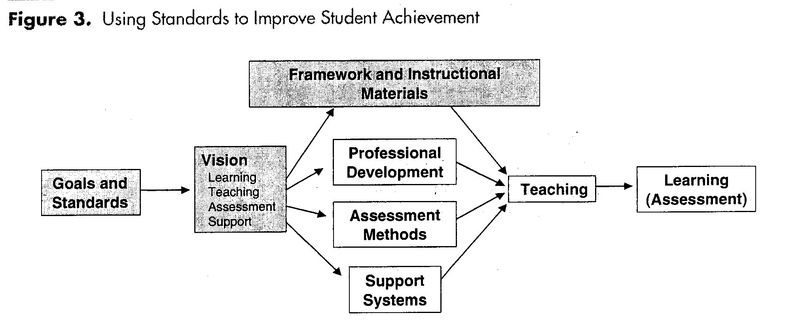 | 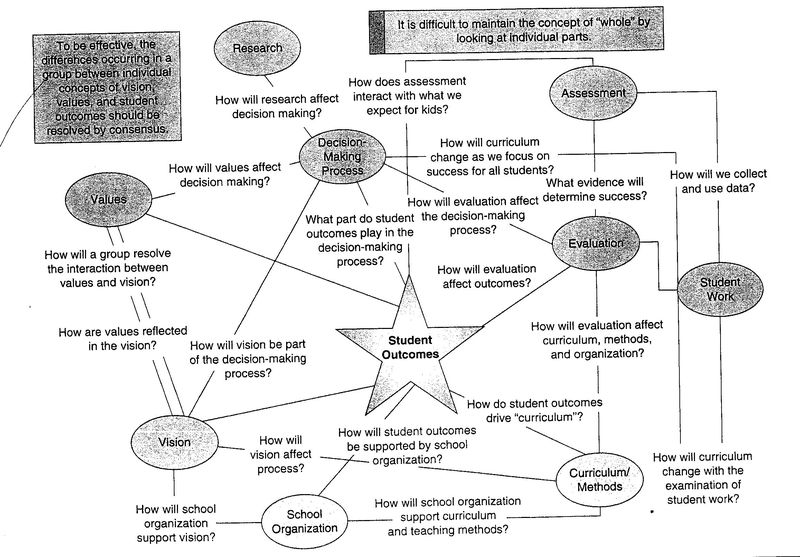 |
接著是旅程的觀點,一路會遇到好的壞的人事物,旅途的過程更是寶貴經驗啊!也從生手到專家:

再來看載具的整合設計考量,人因工程的研究環:

最後,總是好事壞事都會經過這樣的流程吧!這裡提到應用魚骨圖的步驟,以及一個車禍的各項關聯例子:

我想提醒自己的是:無論老師或學生~正向思考與積極動力最重要,期待好事發生與避免壞事出現,都可以藉著用心設計、準備,來開創未來喔!加油加油!
 安裝ATLAS.ti試用版來玩文獻閱讀
安裝ATLAS.ti試用版來玩文獻閱讀
作者:塾長 日期:2011-09-24 16:19
在『ATLAS.ti 』網站可以下載免費測試版 ,填一下申請表就可以下載。這裡有申請與安裝、教學影片畫面的PDF 。
一早在k書中心,先是買了「你會對你的電腦說謊嗎?:從人和電腦的互動,了解如何成功經營人際關係 」、『讓創意自由 』,準備開始讀papers時想到:你有對搜尋而來的資料、或是自己的閱讀畫註、筆記,進行再搜尋嗎?好像都還沒有個好方法做個統合集結呢!索性藉著體驗『ATLAS.ti』來想想。
安裝軟體與使用時,我沒讓網路連線,測試版雖然有編輯量的限制,但好像已足夠用來當閱讀文獻的好工具了。或者可以利用分檔案的方式,依主題建立不同專案,免費的試用版應該很足了。

以下就認真讀文獻與整理喔~(全部畫面的pdf )
1.開啟一個新的Hermeneutic Unit後,先加入你準備分析的檔案,他們會出現在P-Docs下拉表中,代表你可以隨時選某文件來閱覽整理。我以PDF檔為例,在下方可以調整檢視大小與頁碼呈現。
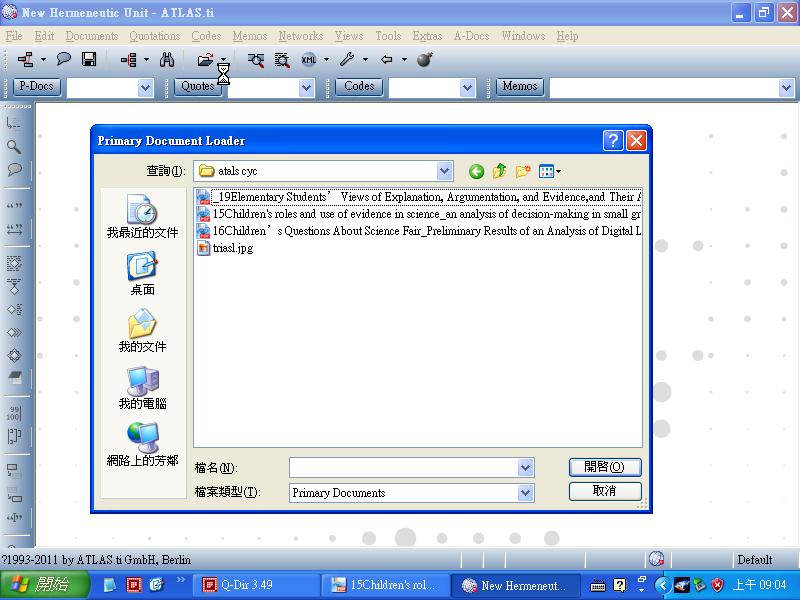 | 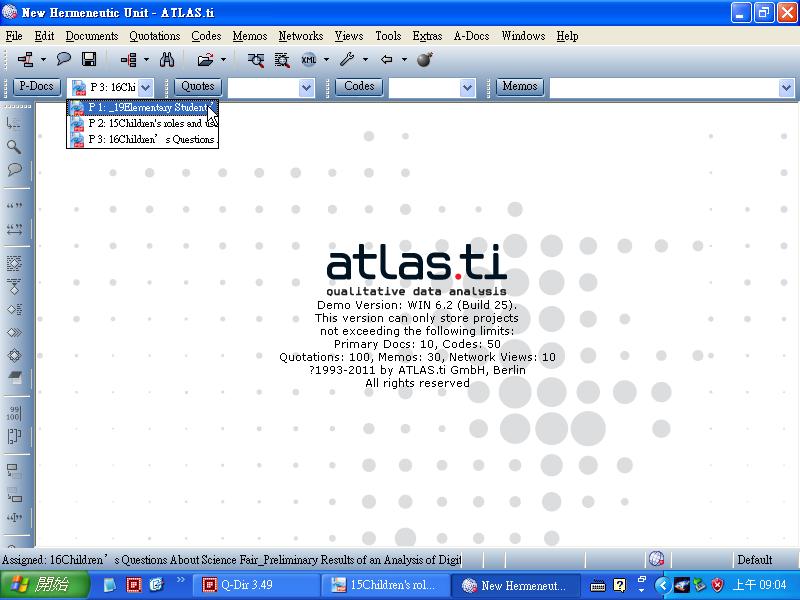 | 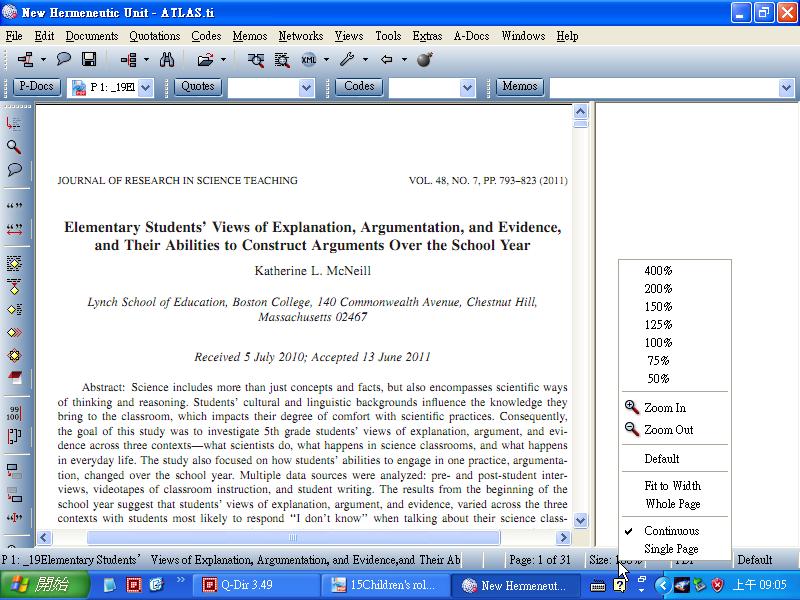 |
2.選取一段文字後按右鍵,建立Quotation(直接抓內文前幾十字當標題),或者直接建立一個Open Coding~給名稱,就可以出現在右列視窗裡,利用右鍵可以重新命名或增加Comments
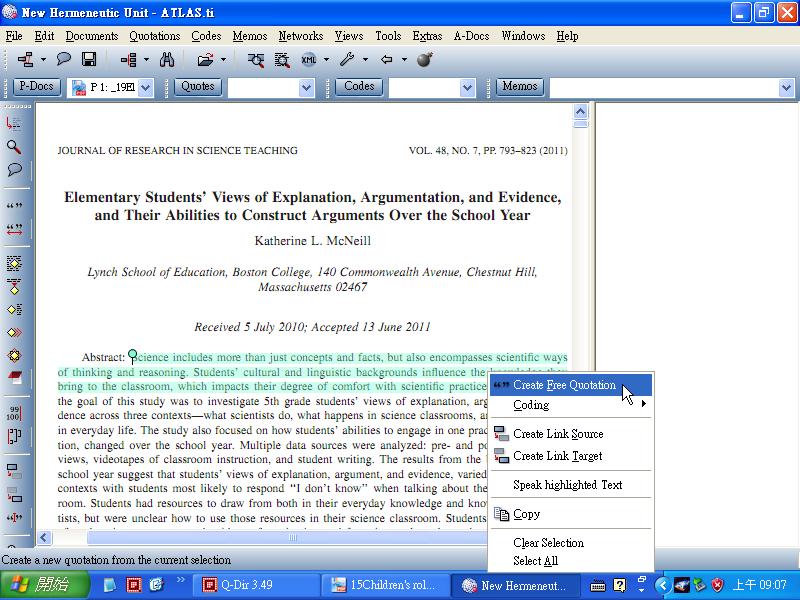 | 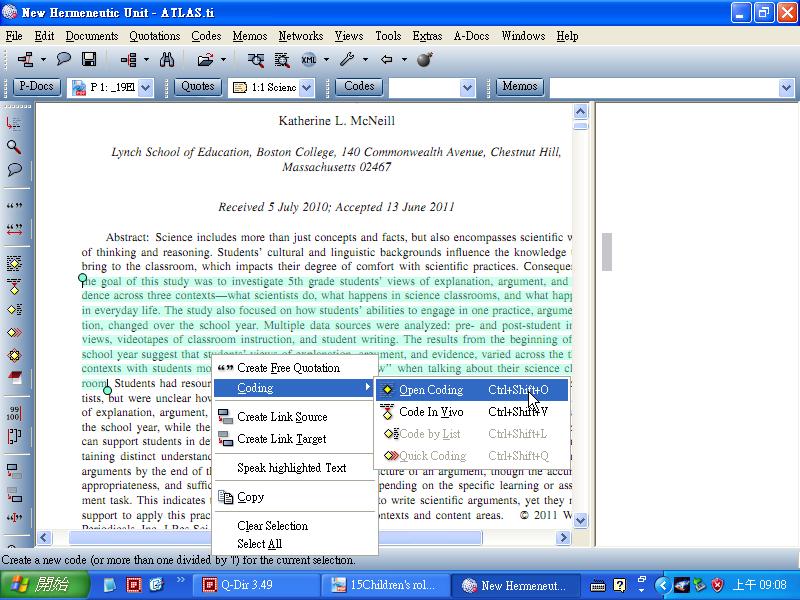 |
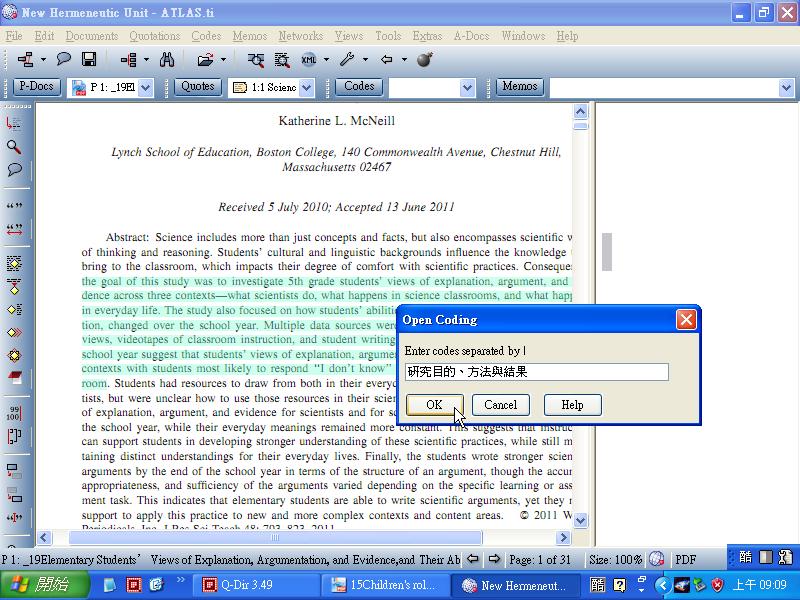 | 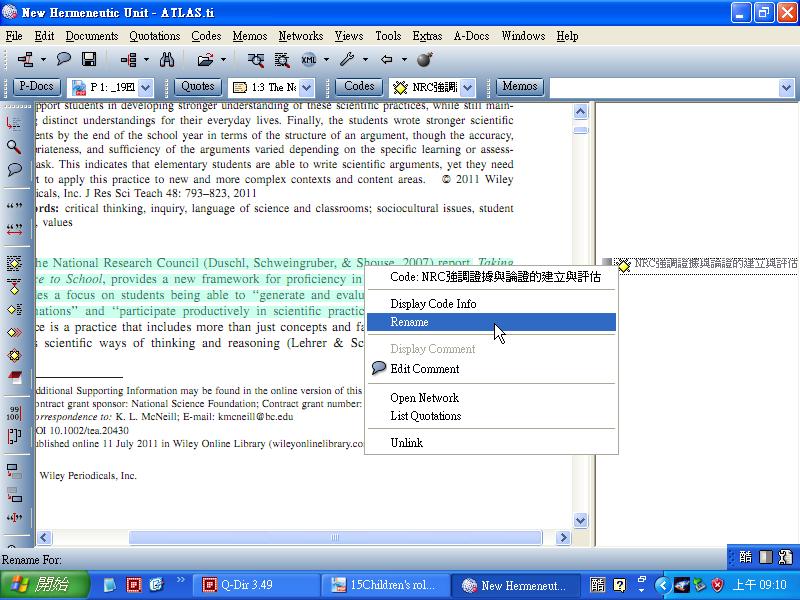 |
3.建立幾個後,就可以在Codes下拉視窗裡自由切換,編寫註解來加上自己的簡譯或想法。
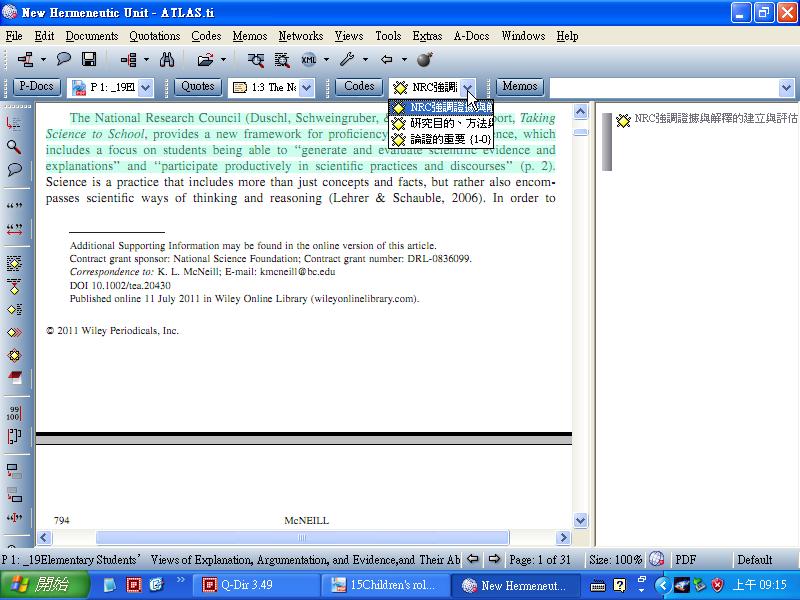 | 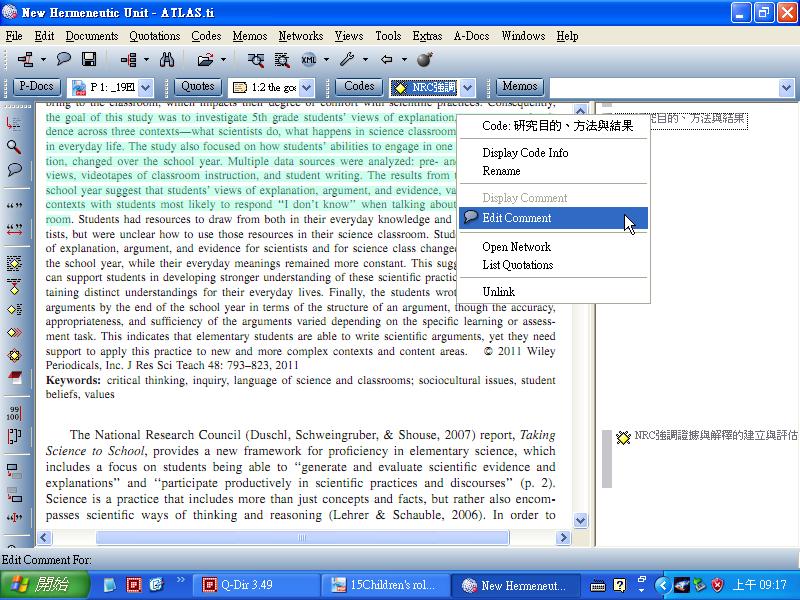 | 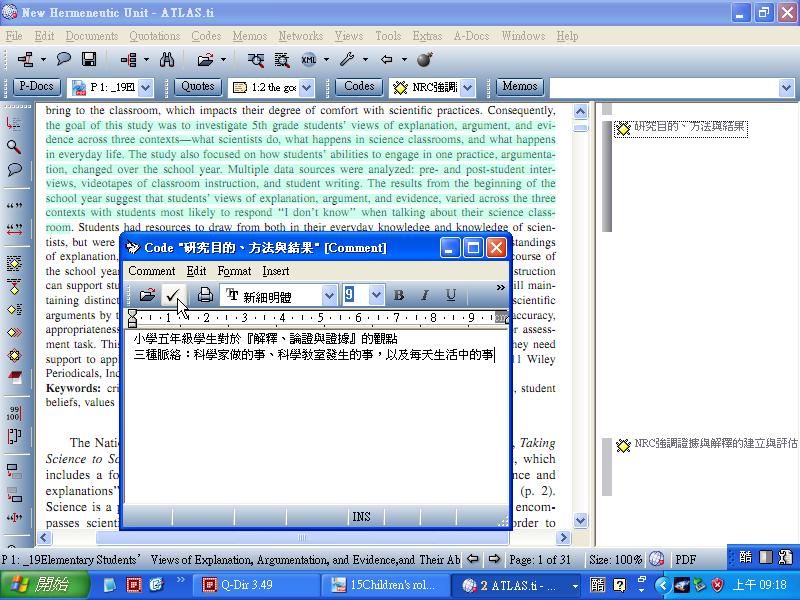 |
4.從Codes功能表開啟Codes Manager,就有清單可逐條檢視,註解欄在下方,也可以這時加上註解喔!
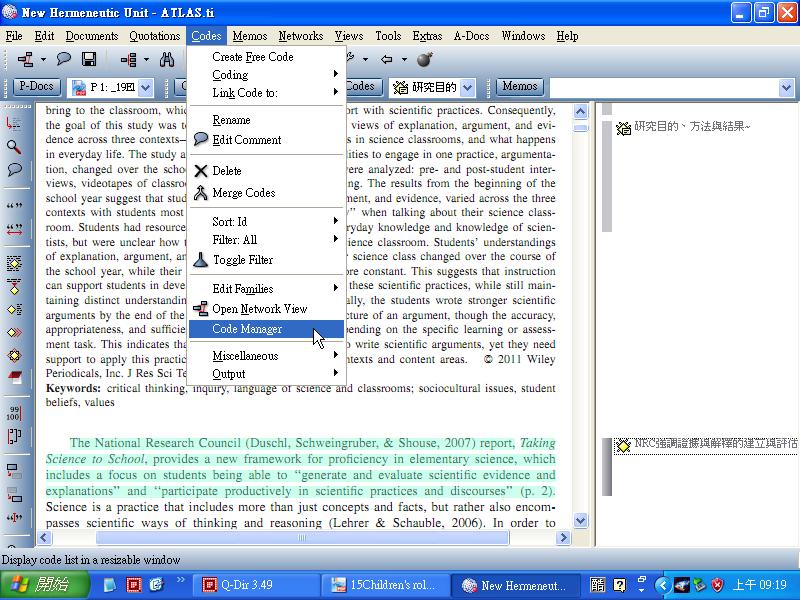 | 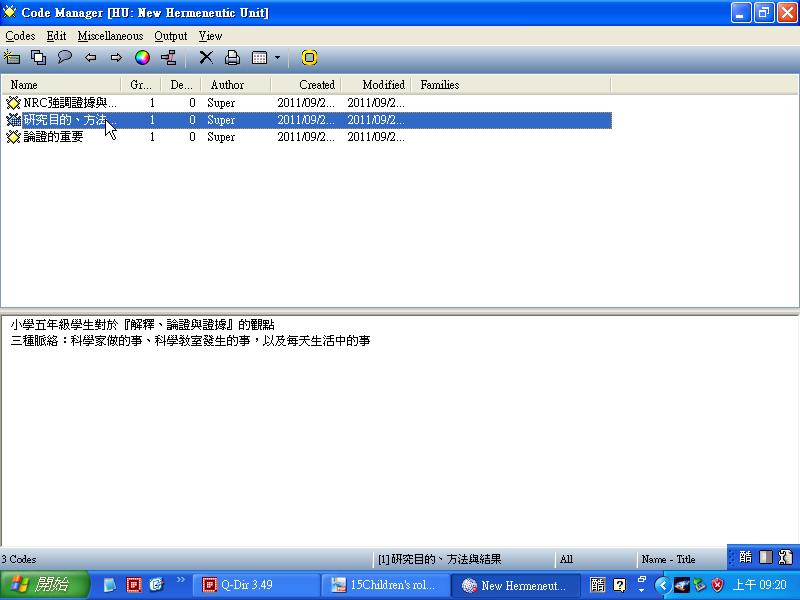 | 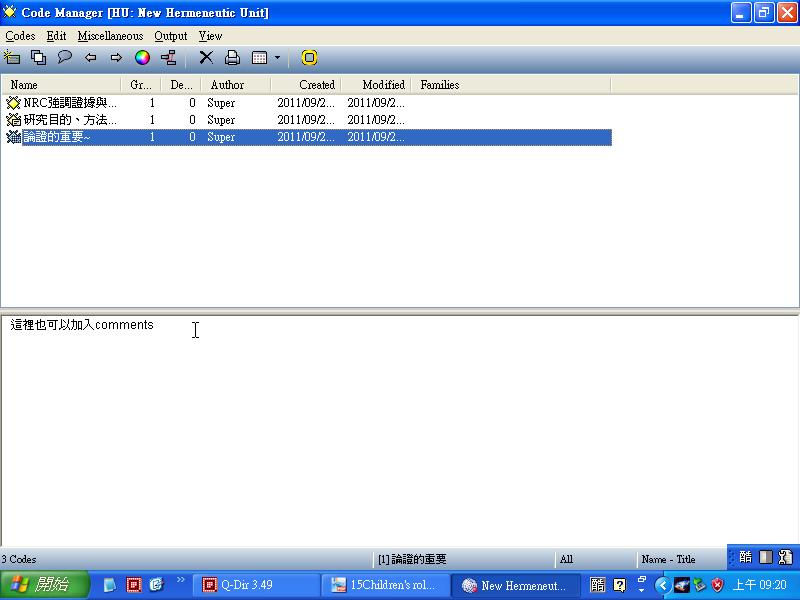 |
5.接著從功能表『Output』→『All Codes with Quotations』,我先選Editor,就可以看到摘錄文句與自己的Code描述。
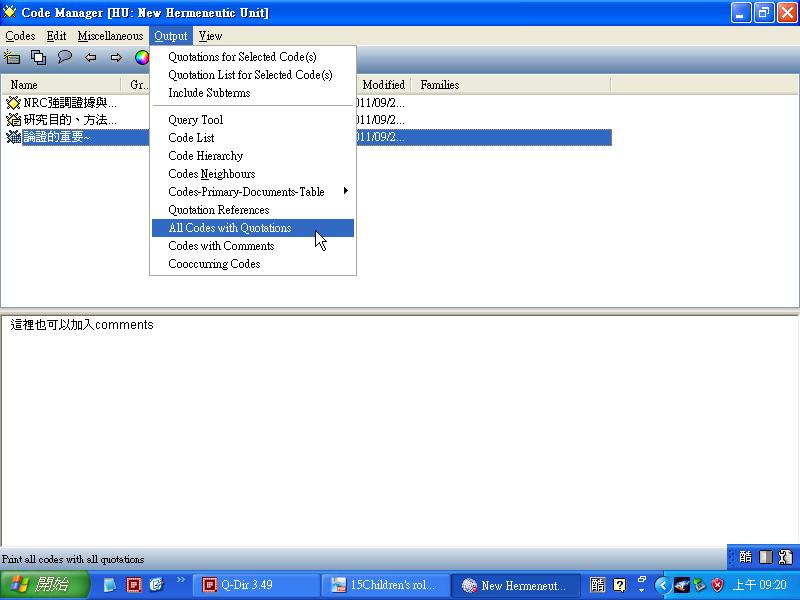 | 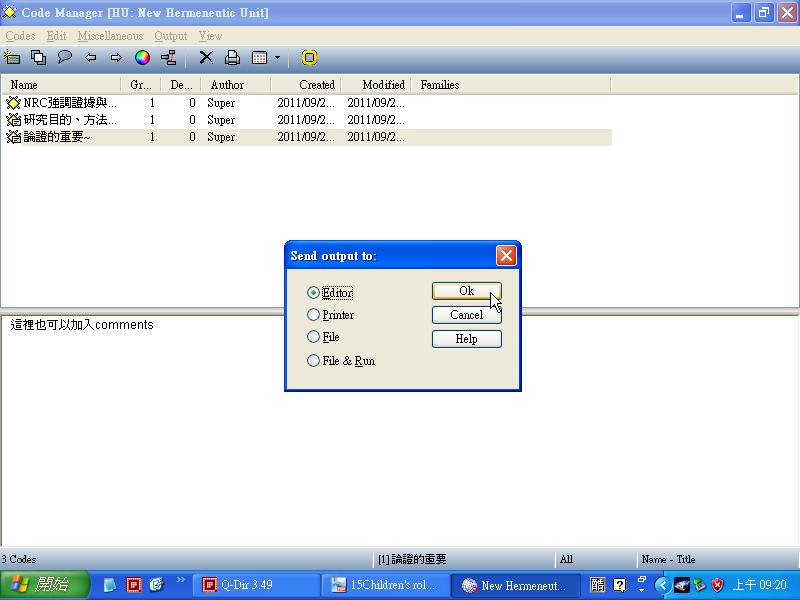 | 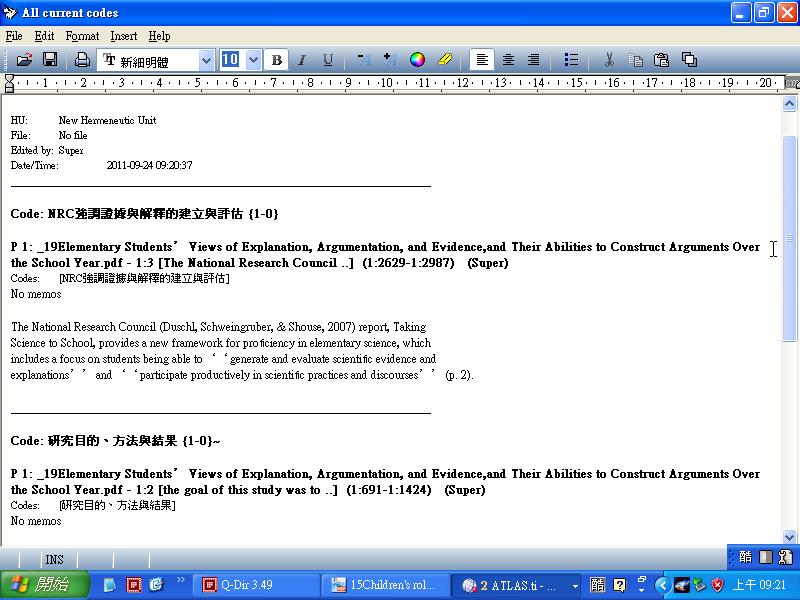 |
6.若是選擇『Codes with Comments』,就只有Codes 與 Comments。所以心得是~把摘錄文句複製一份到Comments,就可以中英混搭地呈現喔!
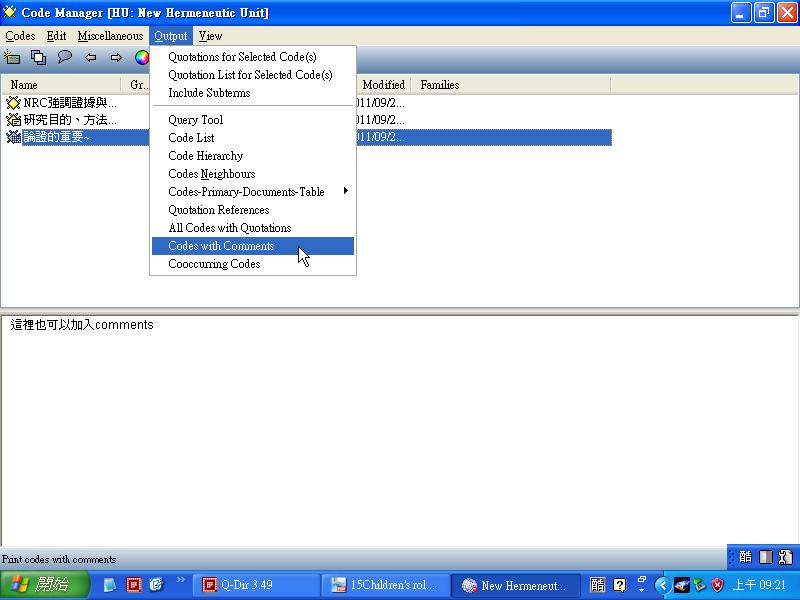 | 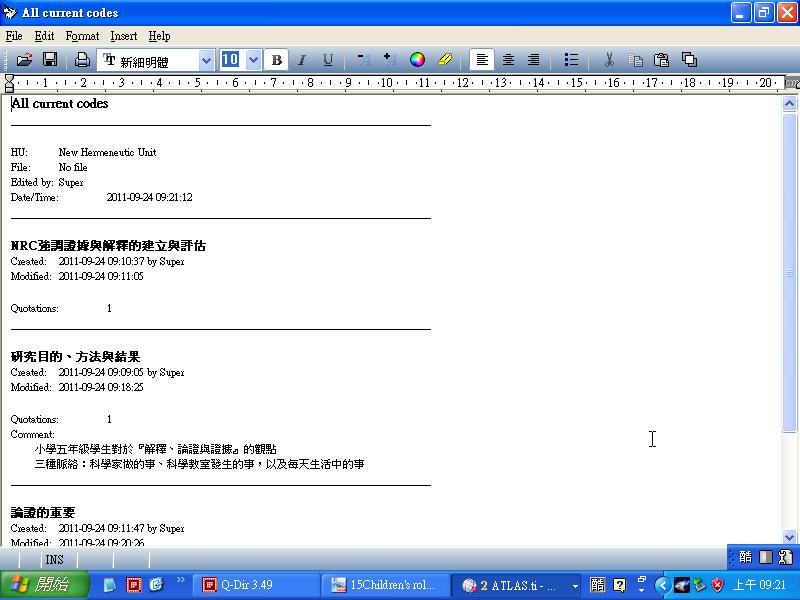 |
7.開啟多份文件也建立Codes後,也可以混合放在一起喔!
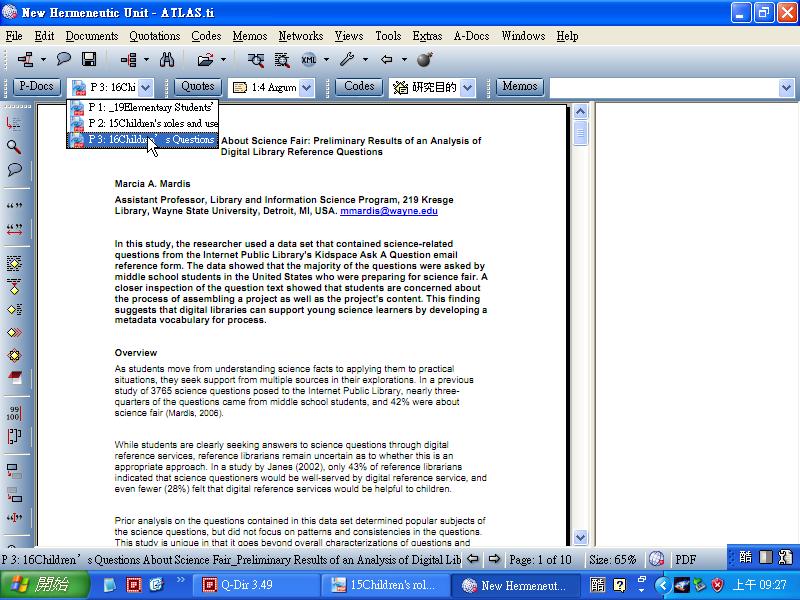 | 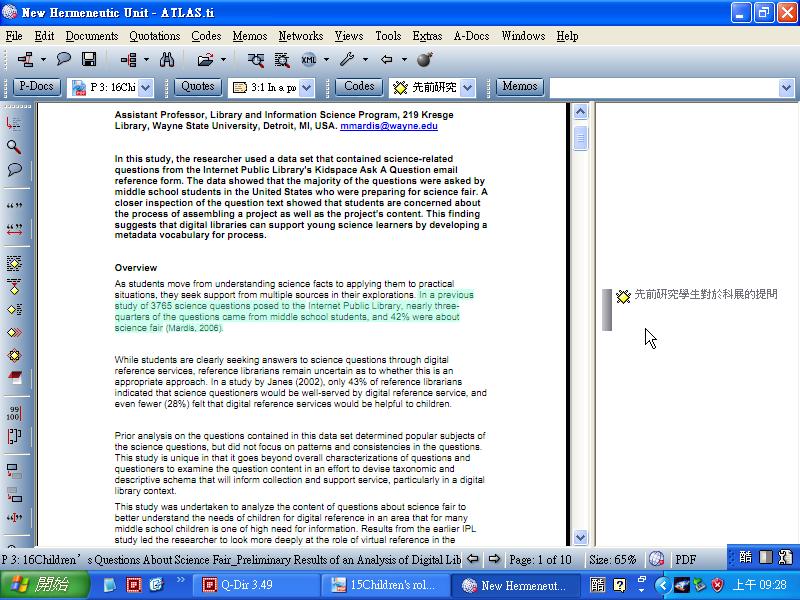 | 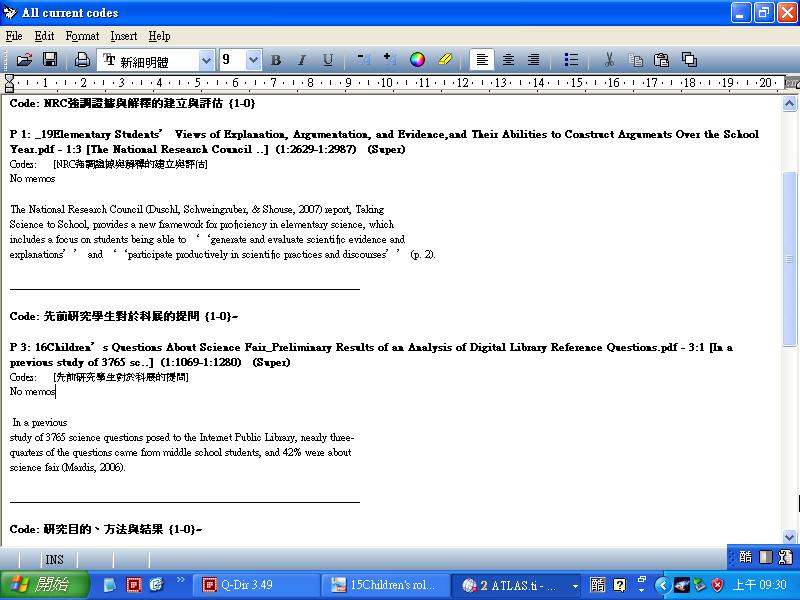 |
這樣真有『凡走過必留下痕跡』的感動呢~看原著資料,畫記重點、加上自己命名、註解,最後整體匯出。雖還不到質性研究的進行,但閱讀文獻的話,這樣就綽綽有餘了喔! 
後記:適用版的50 Codes限制,是指單一專案喔!若超過就警示你而不能存檔。沒關係,另開專案來玩、或者匯出來整理後就可以刪掉一些Codes。

 老師的ASSURE教學經營~看NETS.T、蓋聶(Gagne′)學習條件與NHLP
老師的ASSURE教學經營~看NETS.T、蓋聶(Gagne′)學習條件與NHLP
作者:塾長 日期:2011-09-22 05:35
參考NETS-T 老師的教育科技指標(我的簡譯 ),善用數位科技,老師可以:1.促進和激勵學生的學習和創造力、2.設計和開發數位時代的學習經驗和評量、3.示範數位時代的工作和學習、4.提昇與示範數位公民身份和責任、5.投入專業成長和領導。
然而,課堂時光還是可以從『蓋聶(Gagne′)學習條件論 』的常軌來做教學事件的安排:從一瞬間的事件到一節課裡,師生互動與科技整合的整體學習脈絡,都能找到可以出手操弄與經營之處。我找的教學事件圖片從工作記憶到教學事件(結合ARCS動機模型 )與媒體應用:
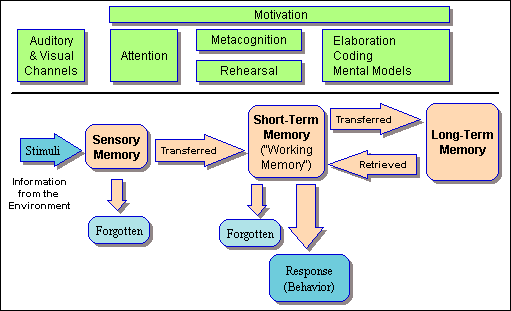 | 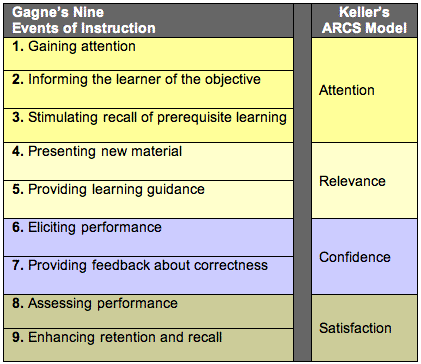 | 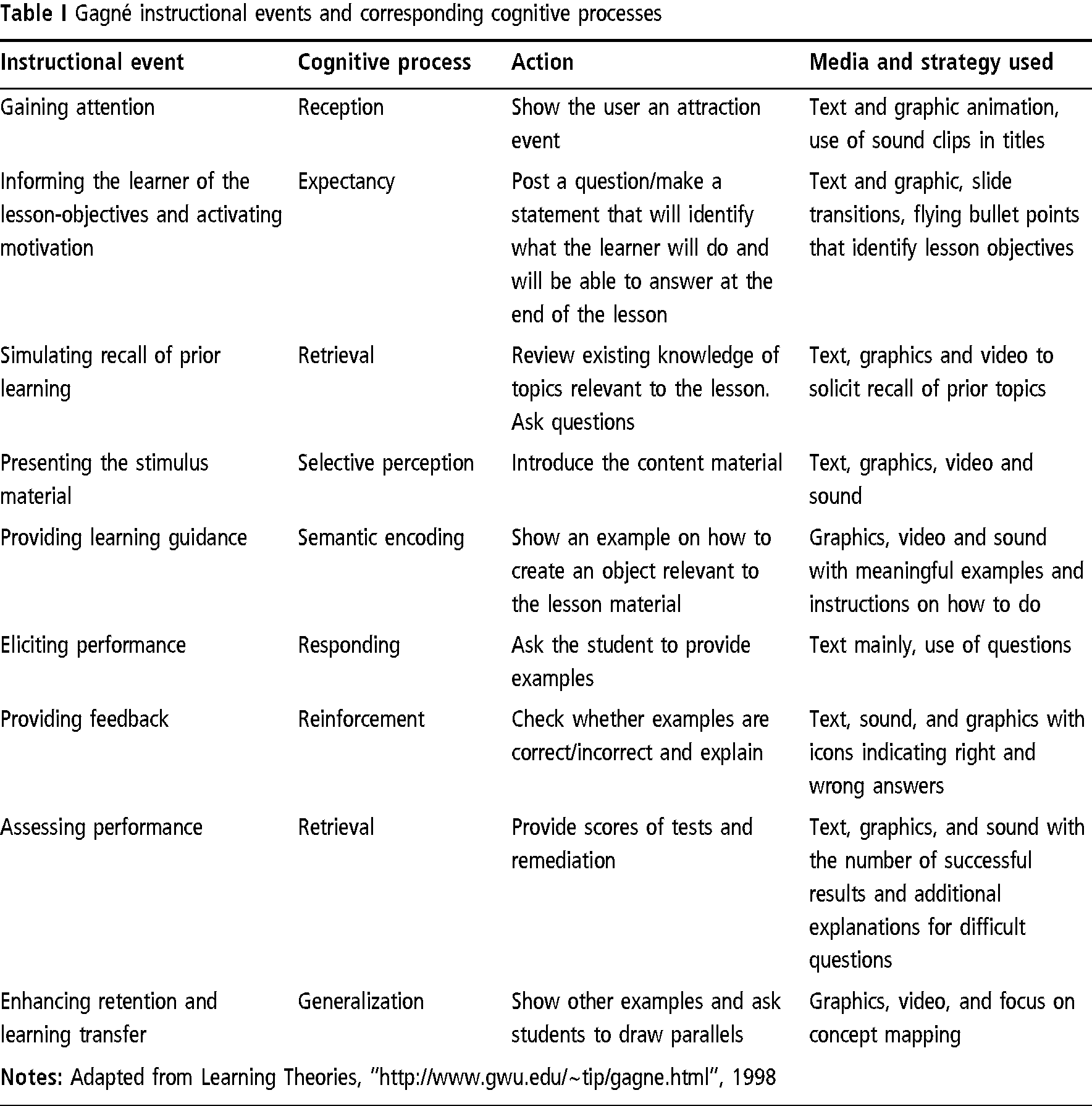 |
最後介紹這個NHLP(網站 、指引doc )~『The Natural Human Learning process(人類自然學習過程)』的課程發展架構,是從『We’re Born to Learn: Using the Brain’s Natural Learning Process to Create Today’s Curriculum』書中找看到的,我喜歡這種一半斜屋頂的合體概念~學生能力逐級而上,而老師由上而下逆推設計,再到個人、小組與全班的形式,針對學生各階段能力來規劃學習任務,既能整合大腦學習原則,也符合當今教學現場常見的師生組成型式呢!下面截圖都在指引doc喔!
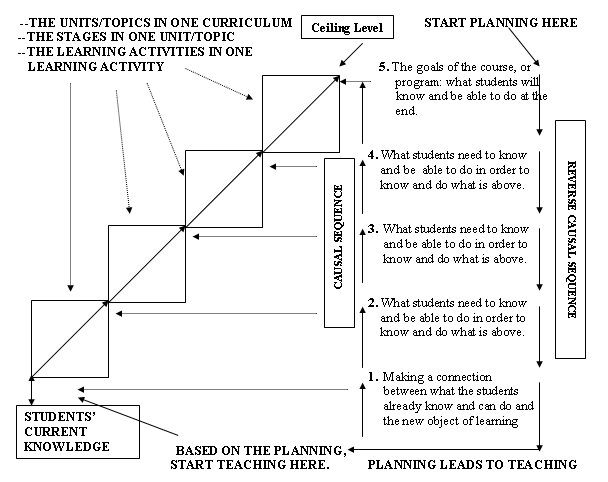 | 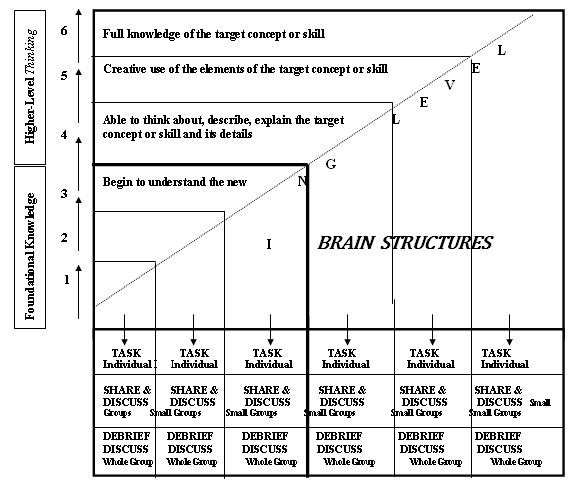 | 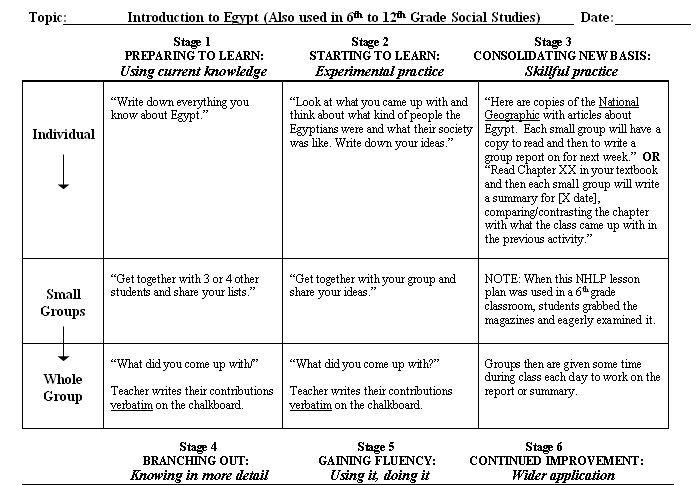 |
小尷尬一下~從寒假看到這本書,歷經整個下學期、再到暑假又過完了,今天準備出發到台東 前,才第一次認真介紹它....
總而言之,咱們的使命,都是為了確保教學有效(ASSURE)喔!
 學生的科技創造力~看NETS.S、數位Bloom與多元e智慧
學生的科技創造力~看NETS.S、數位Bloom與多元e智慧
作者:塾長 日期:2011-09-21 21:25
我把這三項『NETS.S、數位Bloom與多元e智慧』整理在一起,看待學生利用科技該學習與可以表現的機會。
NETS.S 是美國的教育科技標準的學生能力描繪(我的簡譯 ),六個能力面向:1.創造力和創新、2.溝通和合作、3.研究和資訊流暢、4.批判思考,問題解決和做決策、5.數位公民、6.科技操作和概念。另外還有NETS-S學生ICT素養分齡簡介(pdf檔 )(我的簡譯 )
之前介紹過Bloom認知學習目標轉化為第二版:以『記憶、理解、應用、分析、評鑑、創造』六面向代表行為,學習與表現不同類型的知識『事實知識、概念知識、序性知識、後設認知知識。我還找到數位Bloom(pdf檔 ),除了介紹兩版認知目標差別,再加上可以應用的數位工具、教學簡案與表現層級,很具參考價值喔!

加上最近『Bloom’s Taxonomy: The 21st Century Version 』、『Google Blooms Taxonomy 』、『iPad Applications In Bloom’s Taxonomy 』,也可以看見基於能力項目的科技應用與教學開展。
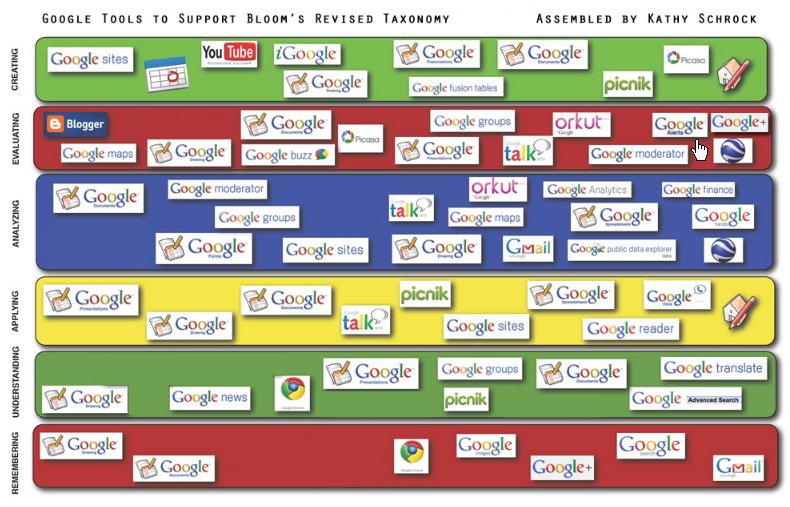 | 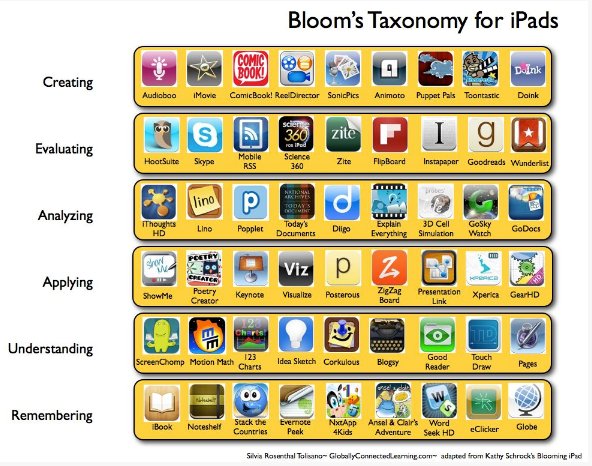 |
最後,再看多元e智慧(ppt slides ),也早有將各類型智慧與數位工具的整合呈現喔!
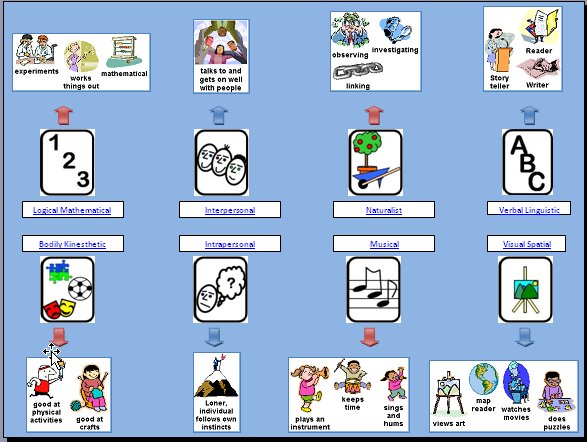 | 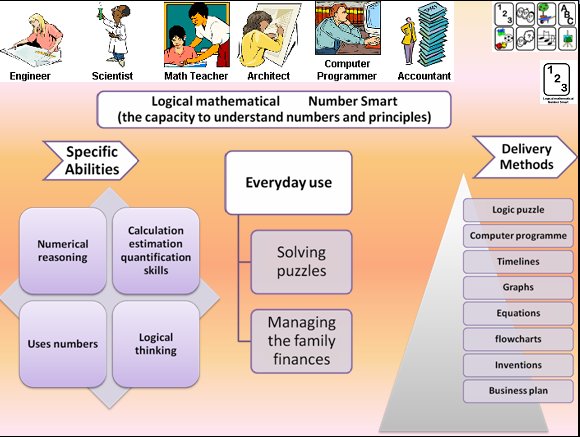 | 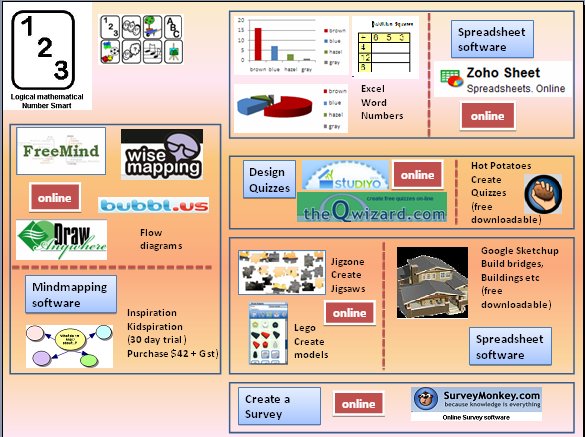 |
或許不必等到個孩子都有科技載具,我們也可以營造這樣的教學多樣性數位槓桿學習環境喔!加油加油!

